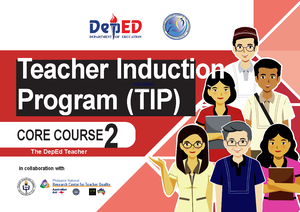- Information
- AI Chat
Was this document helpful?
Part 6 General Education www
Course: Education (BSED 4)
901 Documents
Students shared 901 documents in this course
University: Eastern Samar State University
Was this document helpful?

This reviewer was submitted to www.teachpinas.com
Get more Free LET Reviewers @ www.teachpinas.com
Part 6 General Education (150 Items)
1. Which of the following statements is definitely
true about the nature of science?
a. Science will help make the world a better place to
live in.
b. Science can always uncover the truth in the
realm of nature.
c. Scientific work requires a dedication that
excludes the lives of people in other fields of work.
d. Theories in science can be disproved by testing:
a well established theory can be demolished with a
single observation.
2. Which of the following processes is best
associated with technology than with science?
a. designing for a need
b. uncovering natural phenomena
c. discovering the nature of matter
d. constructing concepts, principles and laws
3. Which of the following statements best describes
the connection between science and technology?
a. Scientist use the laws and principles discovered
by technologists.
b. Technology is the part of science that deals with
mechanical problems.
c. Technology involves the practical applications of
scientific knowledge.
d. Science depends on technology for ideas and the
organization of experimental work.
4. Which of the following is a technological concept
rather than a scientific concept?
a. Tungsten has a high melting point.
b. Metals are good conductors of heat.
c. Resistance is inversely proportional to current.
d. Fluorescent lamps are improved through
methods of manufacturing.
5. You want to add exactly 35.00 g of salt to a
solution. What instrument must you use to measure
this amount?
a. beaker
b. thermometer
c. graduated cylinder
d. triple beam balance
6. Young people stand straight. Very old ones
usually stoop. Why?
a. Sedentary lives of the old.
b. Habit of stooping developed in the old.
c. Greater gravitational pull on the old than on the
young.
d. Bones of the old have become weak and soft and
their joints become loose.
7. Why is it not quite possible for viruses to live and
multiply in the outer layers of our skin?
a. The outer layer of the skin has dead cells only.
b. The outer layer of the skin has oil which is
harmful to viruses.
c. The outer layer of the skin has a lower
temperature unsuitable for viruses.
d. The outer layer of the skin has salt from
perspiration which is harmful to viruses.
8. Alcohol thermometer works on the principle that
a. Volume usually increases with pressure.
b. Temperature usually increases with density.
c. Volume usually increases with temperature.
d. Temperature usually increases with pressure
9. Which of the following is an important factor in
explaining why seasons occur?
a. Earth's axis is tilted.
b. The sun's axis is tilted.
c. Earth rotates on its axis.
d. The sun rotates on its axis.
10. To preserve the fertility of the soil, farmer
should employ the following except
a. strip cropping c. terracing
b. continuous farming d. contour farming
11. How can the presence of a person afflicted with
HIV and/or AIDS be handled?
a. Discreetly reporting the case to health
authorities.
b. Conducting home forum to discuss the
identification of AIDS cases.
c. Avoid and discourage patronage of places
frequented by these persons.
d. Discourage the establishment of recreation
centers like cabarets and discos.
12. The following describe chemical change except
a. A chemical change takes place when a solid is
changed to liquid then changed to gas
b. For a chemical change to take place, heat, light,
or electricity is either needed or given off.
c. Some examples of chemical change are souring
of milk, ripening of fruit, and digestion of food.
d. In a chemical change, a new substance is formed,
with chemical properties that are difft rent from, the
original substance
13. Where do we trace the El Nino phenomenon?
a. rising ocean levels
b. very severe earthquakes
c. annual changes in seasons
d. thinning or depletion of the ozone layer
14. Why does the greenhouse effect result to
warmer temperature near the earth's surface?
a. clouds trap infrared radiation
b. soil absorbs incoming radiation
c. ozone traps ultraviolet radiation
d. carbon dioxide traps infrared radiation
15. Why do people feel warmer just before it rains?
a. Heat released by the condensation of water
vapor.
b. The clouds prevent heat from escaping the earth.
c. The increased relative humidity makes them feel
warmer.
d. The warming is due to the heat absorbed by the
evaporation of water.
16. A good method to prevent soil from being
eroded from a hill is to
a. irrigate the area
b. plow the hill regularly
c. plant only ion alternate layers










